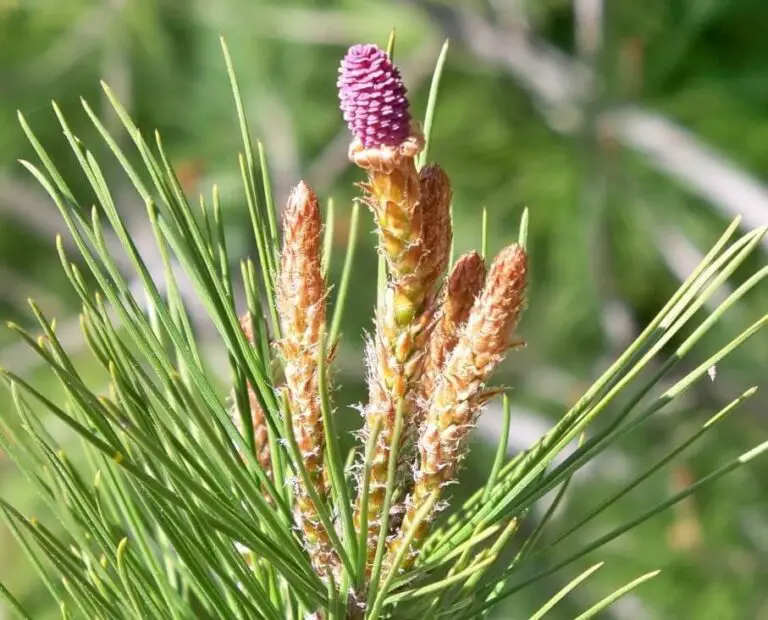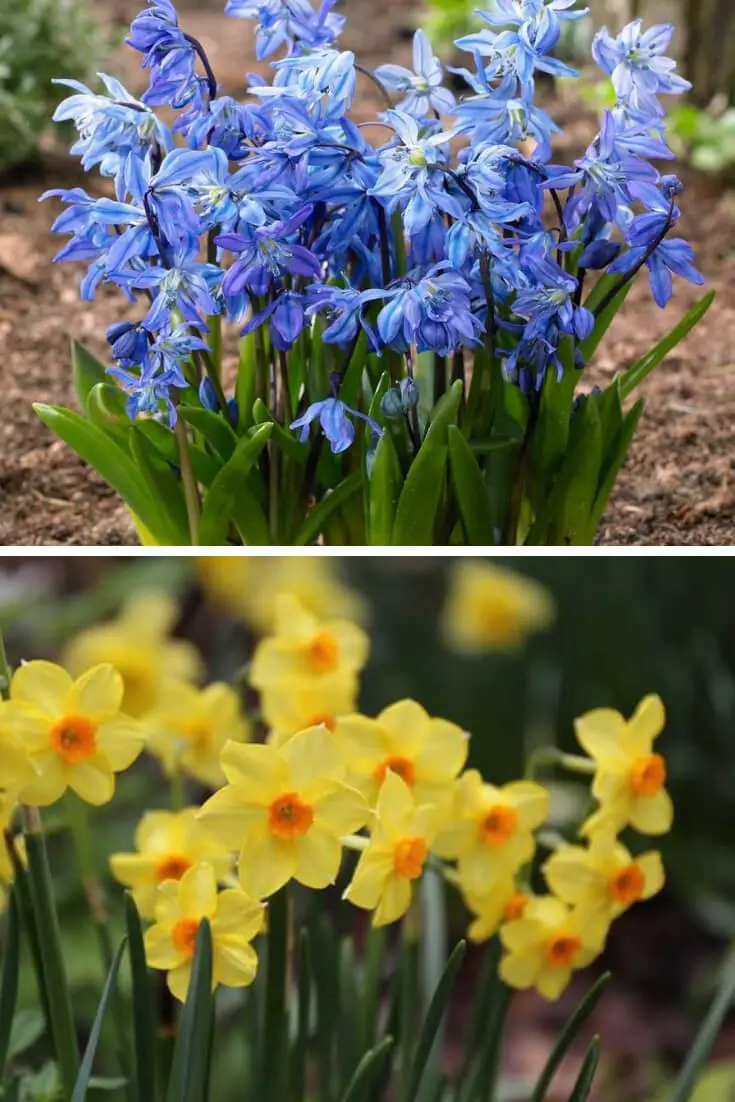33 Different Types Of Holly Trees And Bushes For Your Yard (Leaves, Flowers, Berries)
Looking to add some festive flair to your yard this holiday season? Consider planting a holly tree! With over 30 different species to choose from, each with its unique characteristics and features, finding the perfect one can be overwhelming. That’s why we’ve put together a comprehensive guide to help you navigate the world of holly trees.
From identifying the different types of holly leaves, flowers, and berries, to learning how to care for these beautiful plants, this article will provide you with all the information you need to get started. Whether you’re a seasoned gardener or just starting out, we’ll cover everything from the best time to plant your new holly tree to tips on how to keep it thriving.
Some of the most popular types of holly trees include the Altaclere Holly, American Holly, Apollo Winterberry Holly Shrub, Blue Holly, Burford Holly Shrub, and many more. Each species has its own unique characteristics, from the shape and color of its leaves to the type of flowers and berries it produces.
In addition to learning about the different types of holly trees, we’ll also cover common questions and concerns, such as how to identify a holly tree, which species grow the fastest, and what are some of the best uses for hollies. Whether you’re looking to add some holiday cheer to your yard or simply want to learn more about these fascinating plants, this article has got you covered.
How do I identify a holly tree?
To identify a holly tree, several distinct features can be observed. One characteristic is the presence of spines on the leaves, which can be a distinctive marker. Another indicator is the appearance of red berries, often seen clustered along the branches. In addition to these visual cues, holly trees typically produce small, white flowers that are an important distinguishing feature.
Furthermore, holly trees often exhibit a pyramidal or columnar shape, setting them apart from other tree species. When all of these characteristics come together in a single specimen, it is likely to be a holly tree.
Holly Leaves.
Holly, an evergreen shrub that can grow up to 15 feet in height, boasts dark green leaves with a glossy sheen and sharp spines along the edges. In the spring, small white flowers emerge, followed by clusters of red berries in late summer or fall. Native to Europe, Asia, and North America, this resilient plant has been a staple of many ecosystems for centuries. The leaves of holly are prized for their use in crafting wreaths and garlands, while also serving as a popular Christmas decoration.
Meanwhile, the shrub’s berries may appear inviting to humans, but they’re actually toxic to us – fortunately, birds take delight in devouring them.
Holly Flowers.
Holly flowers, measuring around half an inch in diameter and featuring five petals, are a delicate and charming sight to behold. These small white blooms typically cluster on holly trees and bushes, attracting bees and other insects as they pollinate. In addition to their aesthetic appeal, holly flowers hold significant cultural value – they’re actually the state flower of Alabama!
Furthermore, these blossoms carry symbolic meanings, representing hope, purity, and chastity in the language of flowers. They also serve as a reminder of defense and protection. With their versatility, it’s no wonder holly flowers are often incorporated into holiday decorations like wreaths and centerpieces. They can even be dried to create unique potpourri blends or used to craft fragrant perfumes.
Holly Berries.
Holly berries, with their striking red hue and rounded shape, adorn holly trees. These vibrant fruits have a dual purpose – they’re used to craft festive holiday decorations like wreaths and garlands, as well as in traditional remedies. As a symbol of Christmas and the winter season, the holly berry is often incorporated into decorations, conveying good luck and cheer. However, it’s essential to remember that holly berries are toxic to humans and should not be consumed.
In fact, if someone has ingested them, prompt action is necessary; symptoms of poisoning include vomiting, diarrhea, and stomach pain, while in severe cases, it can lead to a coma or even death. It’s crucial to prioritize caution and seek medical attention immediately if you suspect holly berry ingestion.
Types Of Holly Trees
Altaclere Holly (Ilex x altaclerensis)

In 1901, Charles Maries at Altaclere Park in Hertfordshire, England, successfully bred the hybrid holly known as Altaclere Holly. This unique variety resulted from crossing the English holly (Ilex aquifolium) with the Portuguese holly (Ilex perado). The resulting plant was introduced to the United States in 1929. The Altaclere Holly is an evergreen shrub or small tree, reaching heights of up to 20 feet (610 cm) and boasting a similar spread.
Its dark green, spiny leaves provide a striking contrast to the small white flowers that bloom in the spring, followed by clusters of black berries in the fall and winter. The plant thrives in a range of soils and tolerates full sun to partial shade. Its salt-tolerant and wind-resistant nature makes it an excellent choice for gardens near coastal areas. With its rapid growth rate, the Altaclere Holly can be used as a specimen plant or hedge.
Its natural deer resistance and lack of significant pest or disease issues also make it a low-maintenance option.
American Holly (Ilex opaca)

In the eastern United States, the American Holly (Ilex opaca) stands tall as a native evergreen tree, its dark green leaves adorned with sharp spines. This resilient tree plays a vital role in supporting local wildlife, serving as a reliable source of sustenance and shelter for various birds and animals. In fact, it’s not uncommon to see the American Holly proudly donning its festive red berries – although humans are warned against consuming them, many an animal finds them a delightful treat.
Despite its slow growth rate, the American Holly has been known to thrive for over 100 years, making it a cherished fixture in many ecosystems. As we celebrate this tree’s unique charm and contributions, let us not forget the significant role it plays in providing benefits to both humans and animals alike.
Apollo Winterberry Holly Shrub (Ilex verticillata ‘Apollo’)

For a winter wonderland in your own backyard, look no further than the Apollo Winterberry Holly Shrub. Its unique appeal lies in its ability to provide a burst of color during the colder months, courtesy of its bright red berries that adorn its branches from fall through winter. But that’s not all – this versatile shrub also flaunts delicate white flowers in the spring, adding a touch of elegance to your garden.
Plus, it’s low-maintenance and requires minimal pruning, making it an excellent choice for busy gardeners or those new to the world of horticulture.
Blue Holly (Ilex x meserveae)
Discover the allure of Blue Holly (Ilex x meserveae), a stunning hybrid shrub that combines the best qualities of English holly (Ilex aquifolium) and Chinese holly (Ilex cornuta). This majestic evergreen can grow up to 15 feet tall, boasting dark green and glossy leaves with sharp spines along their edges. The showy white flowers are accompanied by an abundance of blue-black berries, making it a popular choice for landscaping enthusiasts.
When used as an accent plant or hedge, Blue Holly brings a touch of elegance to any outdoor space. With its remarkable adaptability to varied soil and light conditions, this plant is relatively low-maintenance – but does require regular watering and pruning to keep its shape looking its best.
Burford Holly Shrub (Ilex cornuta ‘Burfordii’)
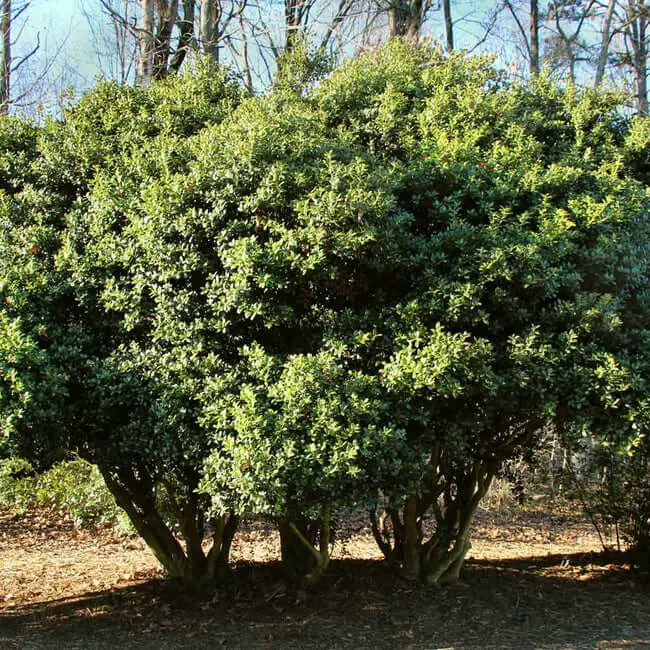
A standout variety in the world of holly, Burford’s ‘Burfordii’ cultivar boasts a remarkable combination of characteristics that make it an excellent choice for various landscaping applications. With its mature height ranging from 15-20 feet and width matching, this fast-growing, broadleaf evergreen is notable for its dark green leaves featuring prominent spines along the edges. Measuring up to four inches in length, these glossy leaves are a striking feature of the plant.
In spring, small white flowers appear, though they tend to be relatively inconspicuous. Following the blooming period, black berries ripen in fall and often persist into winter, providing visual interest during this time.
As ‘Burfordii’ is a female cultivar, it requires the presence of a male holly to produce the berries, which was introduced by A. W. Wilson Nursery (Birmingham, Alabama) in 1963.
This adaptable shrub excels as a hedge, screen, or foundation planting, and its dense foliage also lends itself well to topiary designs. Additionally, it displays remarkable resilience in urban environments, tolerating pollution and salt spray with ease. While it prefers full sun to partial shade, it can thrive in some light shade conditions.
Soil-wise, Burford holly shrubs are surprisingly versatile, thriving in a wide range of soil types as long as they’re well-drained.
Once established, the plant is capable of tolerating drought conditions with minimal maintenance required, aside from occasional shaping or size control pruning.
Carolina Holly (Ilex ambigua)
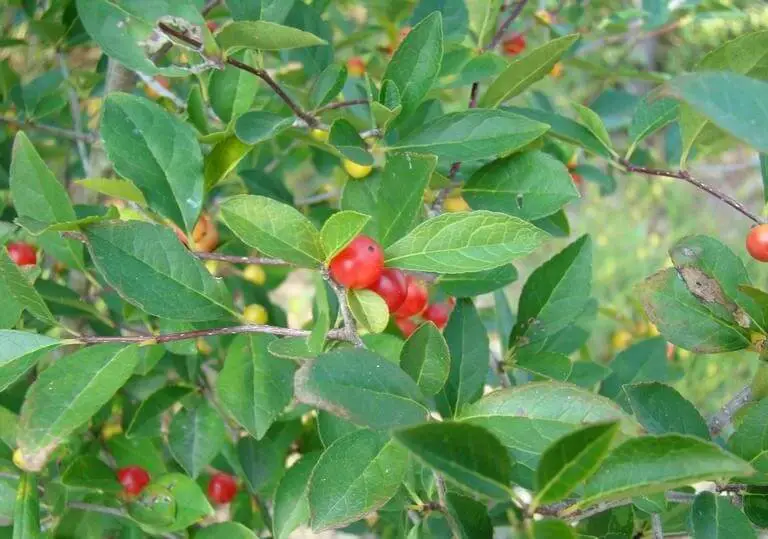
In the southeastern United States, Carolina Holly thrives as a native evergreen shrub or small tree, reaching heights of 15-20 feet. Its elliptical leaves are distinguished by sharp spines along their margins, while white flowers cluster together for added visual appeal. The fruit, a vibrant red berry, ripens in fall and provides a sought-after treat for birds. As a popular landscape choice, Carolina Holly is prized for its attractive foliage and berries.
It can be utilized as a hedge, screen, or specimen plant, offering versatility to homeowners and landscapers alike. Preferring full sun to partial shade and moist, well-drained soils, this holly variety also demonstrates a remarkable tolerance for salt and clay soils.
Catberry (Ilex mucronata)
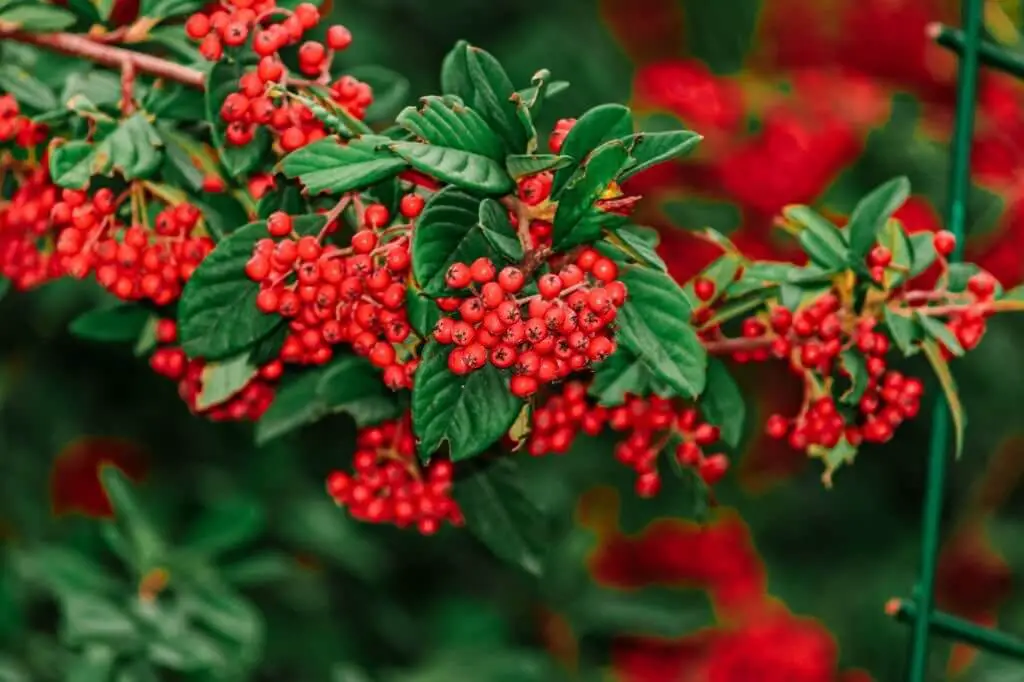
North America is home to the catberry shrub, a native species that thrives in woods, swamps, and along streams from Maine to Minnesota, and as far south as Florida and Louisiana. This deciduous shrub can grow up to 15 feet tall, its small, elliptical leaves featuring a striking contrast between dark green tops and paler undersides. In late spring, catberry shrubs burst forth with white flowers that bloom in clusters from May to June.
As summer gives way to autumn, the fruit ripens – small, dark berries that are highly prized by deer, rabbits, birds, and even humans. Berries can be preserved as jams, jellies, or pies, making catberry shrubs a valuable resource for wildlife and gardeners alike. Propagation is possible through seed, cuttings, or layering, allowing enthusiasts to cultivate these versatile plants in their own landscapes.
Chinese Holly (Ilex cornuta)
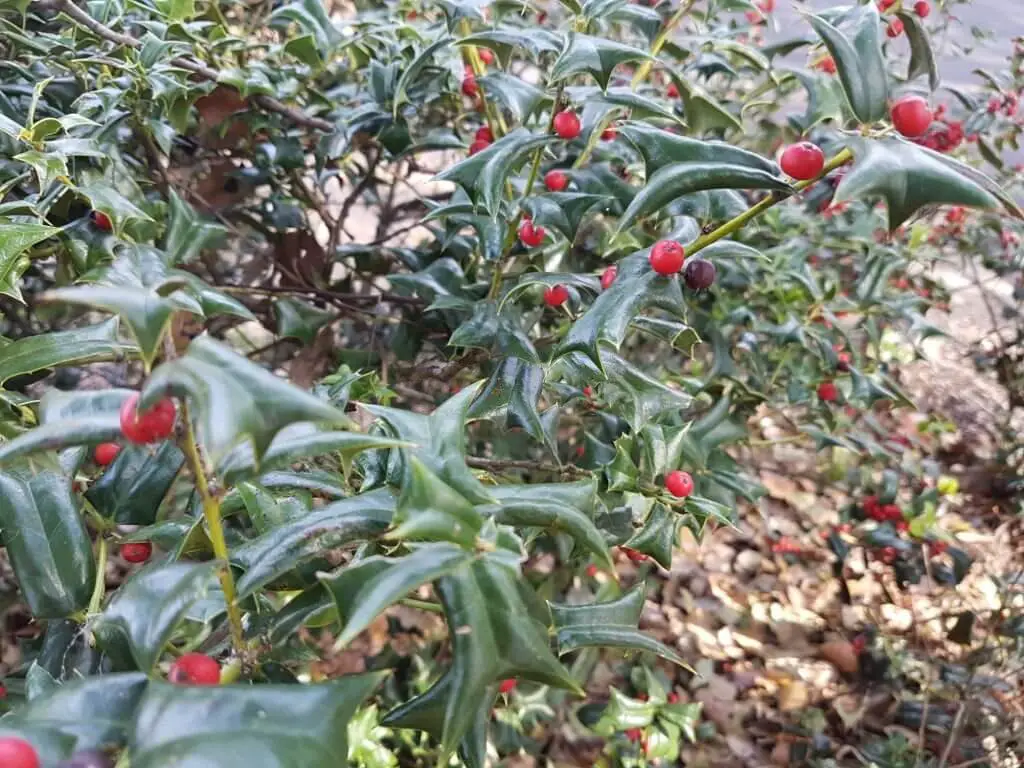
Chinese Holly, a species native to China, boasts an impressive evergreen presence as a shrub or small tree, reaching heights of up to 15 meters. Its leaves showcase remarkable variability in shape, typically featuring three to five lobes, occasionally sporting seven-lobed configurations, and measuring up to 12 centimeters in length and width.
The flowers, dioecious in nature, present themselves as white or greenish-white clusters, while the fruit takes the form of a red drupe containing a single seed. As an ornamental plant, Chinese Holly finds favor in temperate regions worldwide, often utilized as a hedge or shrub that can be pruned to form a compact mound or globe shape. Its versatility extends to topiary creations as well.
Notably, this holly species demonstrates an impressive capacity for resilience, tolerating a broad range of soil conditions and thriving in environments with well-drained, moist soils. It also proves remarkably adaptable, showing tolerance towards urban pollution and salt spray. Propagation is feasible through seed, cuttings, or grafting, making Chinese Holly a popular choice among gardeners.
Common Winterberry (Ilex verticillata)
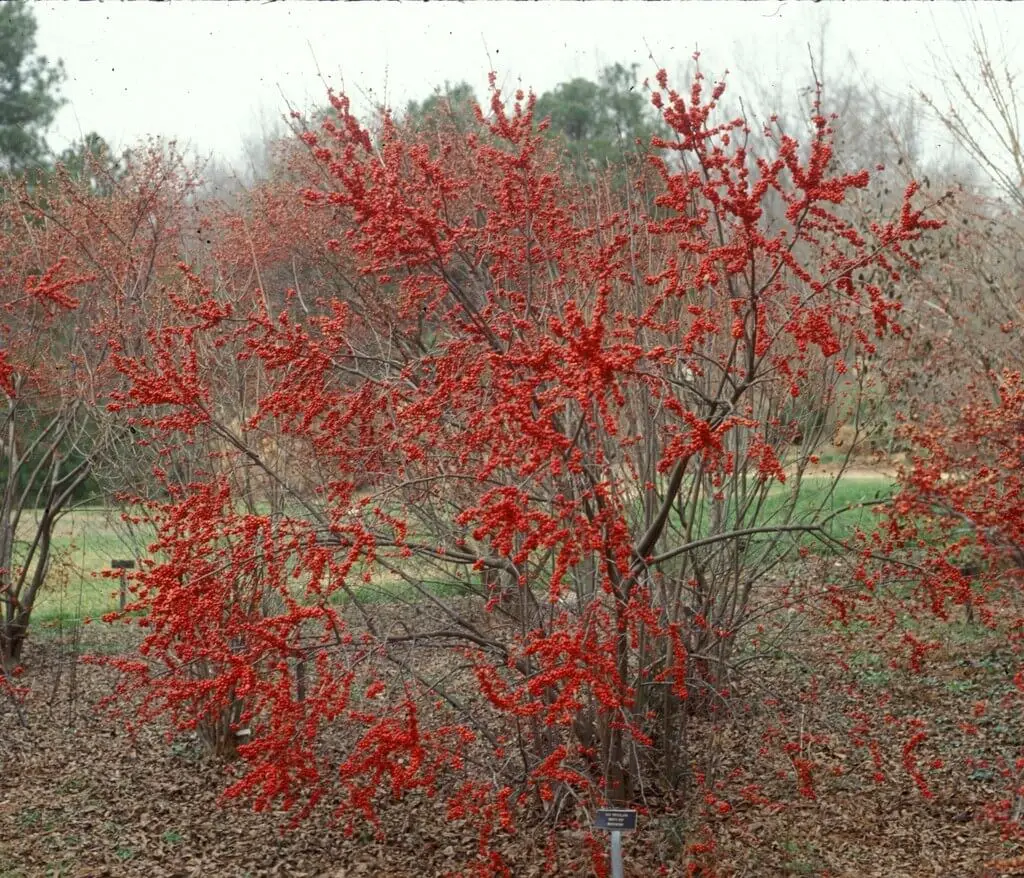
In eastern North America, the Common Winterberry (Ilex verticillata) thrives in wetland environments, where it can grow up to 15 feet (457 cm) tall. This deciduous holly’s distinguishing features include its alternate, simple, and elliptical leaves with serrated edges. The tiny white flowers appear in clusters, while the bright red berries ripen in the fall and persist throughout winter. As a vital food source for many birds and animals, Common Winterberry plays a crucial role in the ecosystem.
Moreover, its berries are prized for making jams, jellies, and pies. Indigenous peoples have also harnessed the plant’s medicinal properties, highlighting its importance in traditional healing practices.
Dahoon Holly (Ilex cassine)
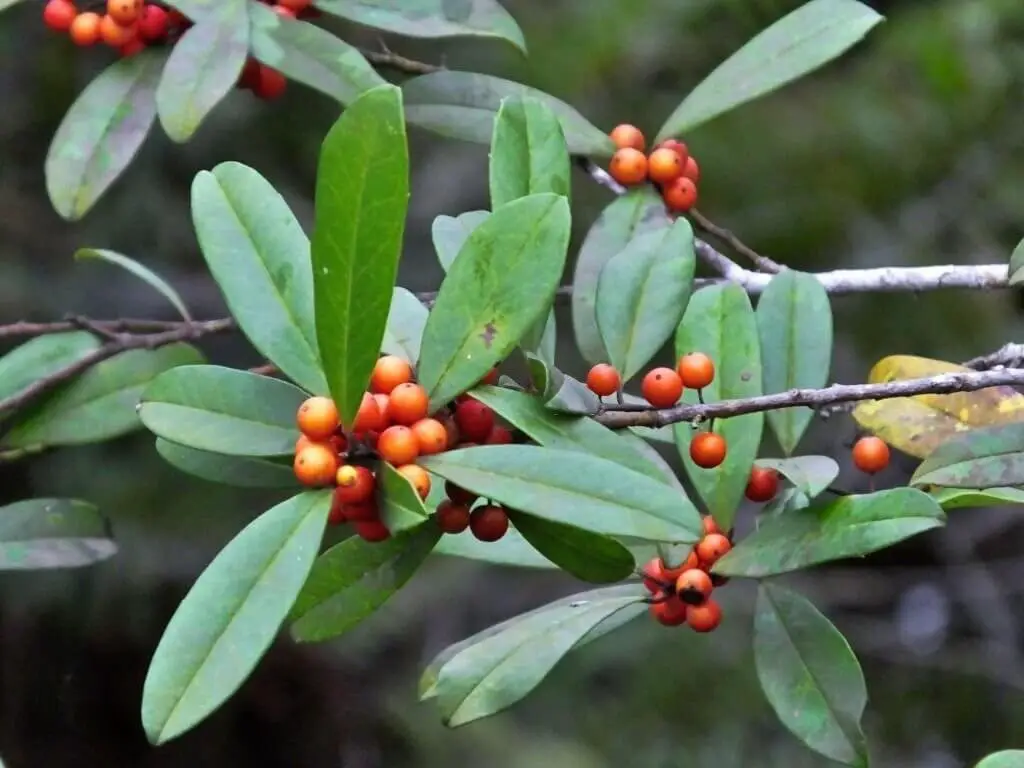
In the southeastern United States, a native evergreen holly called Dahoon Holly thrives in coastal regions stretching from North Carolina to Florida and west to Louisiana. Its striking features – glossy green leaves and vibrant red berries – make it a coveted plant for holiday decoration. When it comes to its growth habits, Dahoon Holly is adaptable, thriving in conditions ranging from full sun to partial shade, with a preference for well-drained soil.
Interestingly, this holly can be propagated through two methods: seed cultivation or cuttings.
Dwarf Burford Holly Shrub (Ilex cornuta ‘Burfordii Nana’)

The Dwarf Burford Holly Shrub is an ideal choice for small gardens or accent plantings, boasting dark green, glossy leaves and delicate white flowers in the spring. Its slow growth rate makes it a great option for maintaining a compact size of around two to three feet tall and wide. This evergreen shrub is not only deer-resistant but also versatile, suitable for mass plantings or hedges. This shrub thrives in USDA hardiness zones six through eight and can tolerate a range of soil conditions.
With minimal maintenance required, it excels in full sun to partial shade and requires regular watering during the growing season. For added convenience, this low-maintenance shrub can be pruned to shape as needed.
English Holly (Ilex aquifolium)
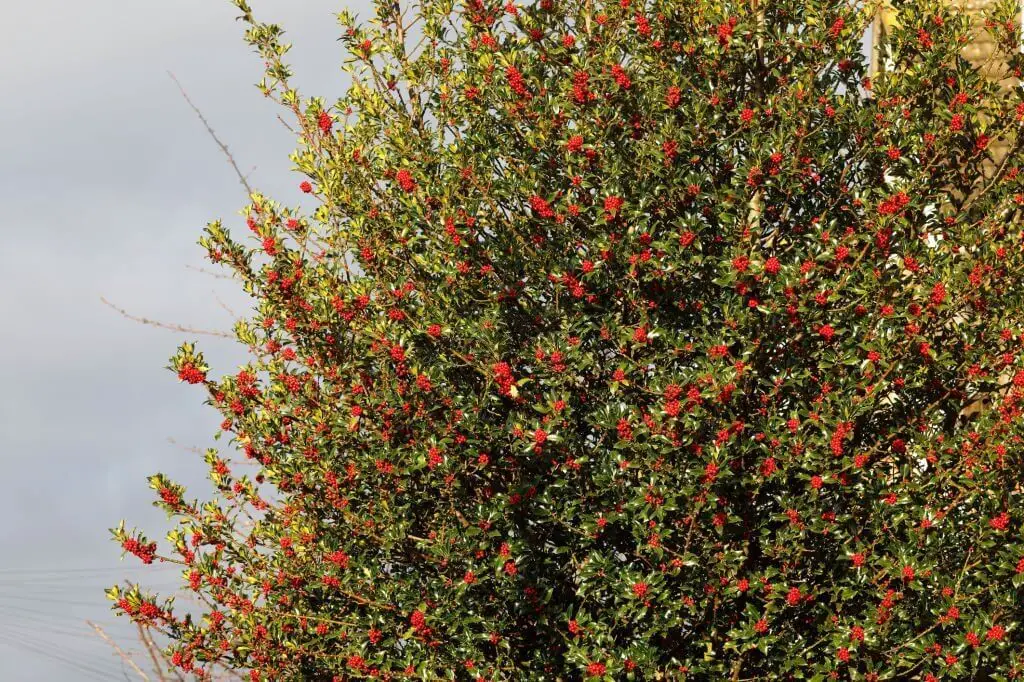
English Holly is an evergreen species that thrives in western and southern Europe, northwest Africa, and southwest Asia. This resilient tree or shrub can grow up to 15-25 meters tall with a sturdy trunk measuring up to 60 centimeters in diameter. The leaves of this plant are incredibly varied, boasting sharp, spiny edges; they’re a deep green hue on top and paler beneath.
Typically measuring around 70 millimeters in length and 30-50 millimeters in breadth, the leaves play host to bees that pollinate the inconspicuous yellowish-green flowers with four petals. The fruit of this species is a vibrant red drupe, approximately 25-35 millimeters in diameter, containing four seeds. This delectable treat serves as a vital food source for birds like thrushes, which facilitate seed dispersal through their droppings.
Interestingly, the English Holly exhibits dioecious tendencies, with male and female flowers growing on separate trees; both are necessary for fruit production to occur. The wood itself is white and hard, capable of achieving a high polish. As a result, it has been utilized since the Middle Ages for crafting into bowls, spoons, cups, and other utensils, as well as furniture and various items. It’s also a popular material for creating walking sticks and canes.
Furthermore, the English Holly is honored as the official state flower of Alabama.
Finetooth Holly (Ilex serrata)
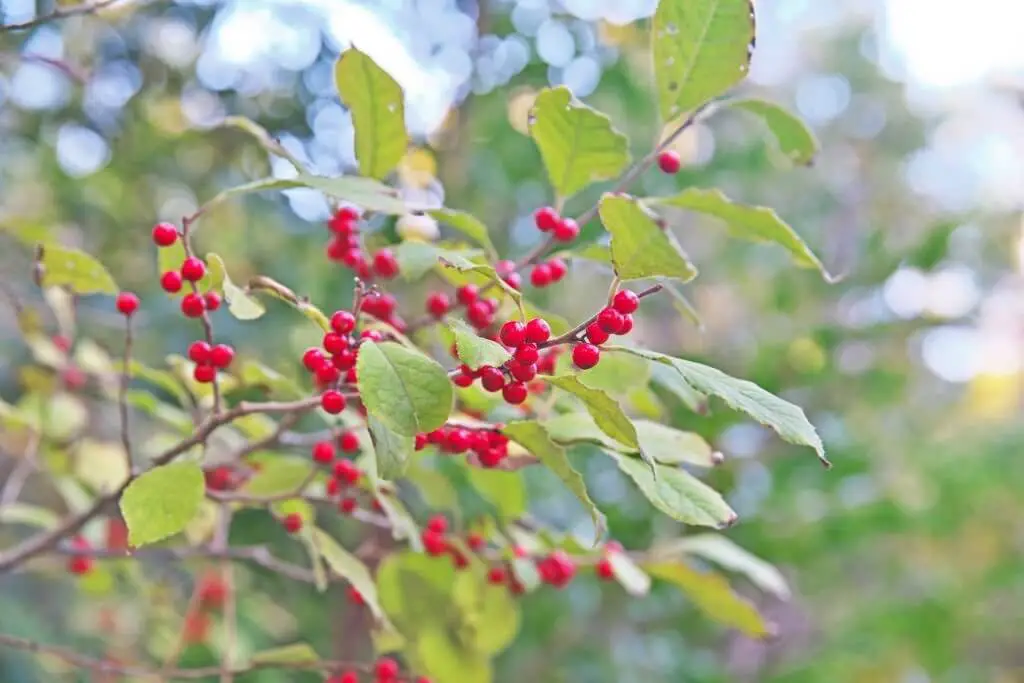
Finetooth Holly, a native evergreen species, thrives in the southeastern United States, its name stemming from the small, sharply toothed leaves that distinguish this plant. Reaching heights of up to 15 feet, Finetooth Holly produces tiny white blooms in the spring, followed by clusters of ripening red berries in the fall.
As a low-maintenance option for landscaping, Finetooth Holly offers year-round visual interest and can be effectively utilized as either a standalone specimen or part of a mass planting. Furthermore, its deer-resistant properties make it an excellent choice for areas where these herbivores are prevalent, providing homeowners with peace of mind knowing their garden will remain intact.
Hawaiian Holly (Ilex anomala)
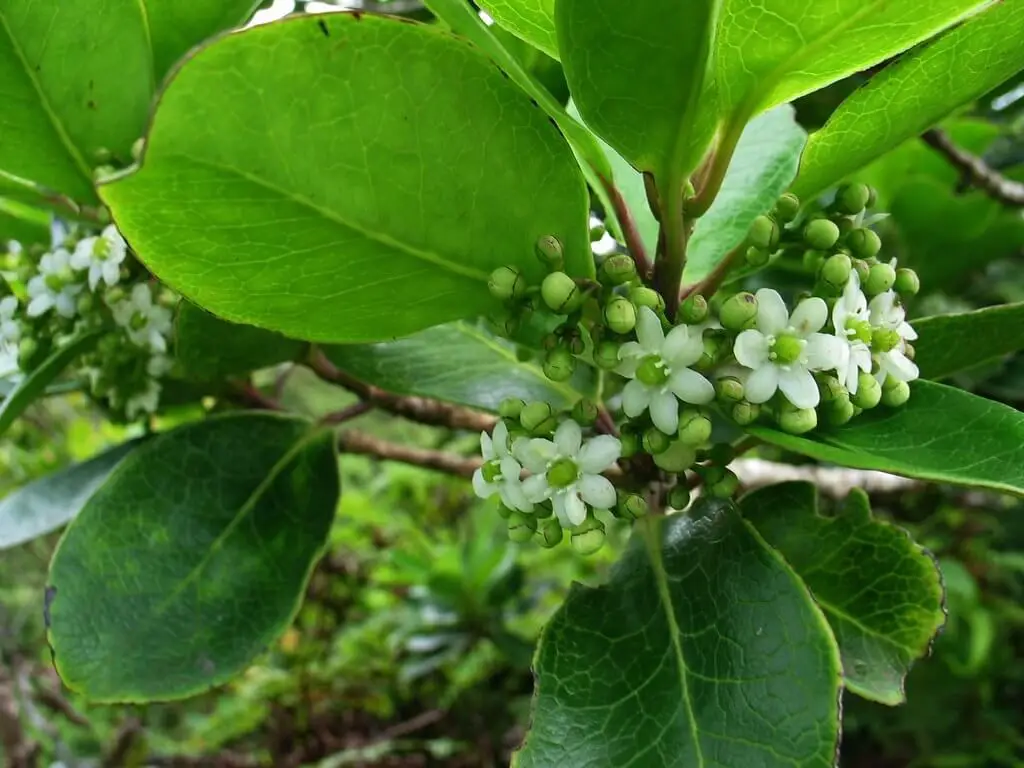
Hawaiian Holly, a member of the Aquifoliaceae family, is endemic to Hawaii and can be found growing as a shrub or small tree. Reaching heights of up to 15 feet (45 m), this plant boasts dark green, glossy leaves that provide a striking contrast to its surroundings. The flowers of Hawaiian Holly are white in color and bloom from April to June, while the fruit takes on a red hue and ripens between August and October.
This plant is typically found in dry to mesic forests and woodlands across all the main islands, often cohabiting with ‘ohi’a (Metrosideros polymorpha) forests. In Hawaiian culture, Hawaiian Holly holds great significance, as its leaves and berries are used in traditional lei making practices. The wood of this plant is also valued for crafting kapa beaters, combs, and other small objects.
Unfortunately, habitat loss resulting from urbanization, agriculture, and ranching has led to the classification of Hawaiian Holly as an endangered species.
Hedgehog Holly (Ilex aquifolium ‘Ferox Argentea’)
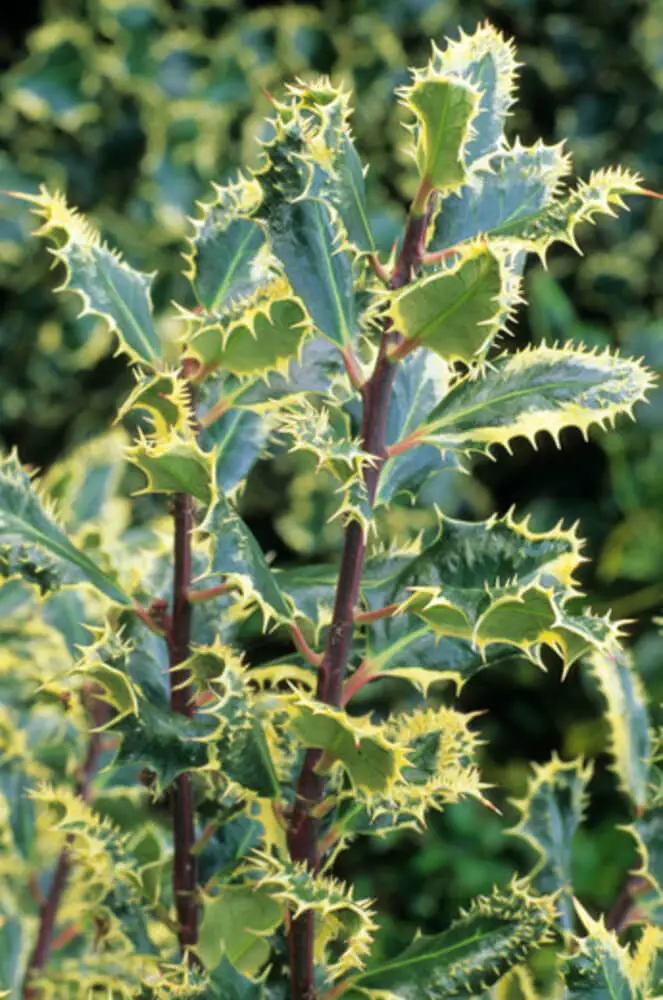
Hedgehog Holly (Ilex aquifolium ‘Ferox Argentea’) is a versatile shrub or small tree originating from Europe. Its dark green foliage gives way to white spring blooms, while the red berries that follow are toxic to humans. Introduced to North America in the early 19th century as an ornamental plant, it has since naturalized in certain regions of the United States. Notably, it is regarded as an invasive species in New York, Connecticut, and Rhode Island.
As a robust grower reaching up to 15 feet tall, Hedgehog Holly thrives in full sun or partial shade. Its adaptability extends to a broad range of soil types, withstanding drought conditions as well. Propagation is possible through seed, cuttings, or division. This evergreen plant offers year-round interest in winter landscapes and can be utilized as a specimen, in hedges, or foundation plantings.
Inkberry (Ilex glabra)
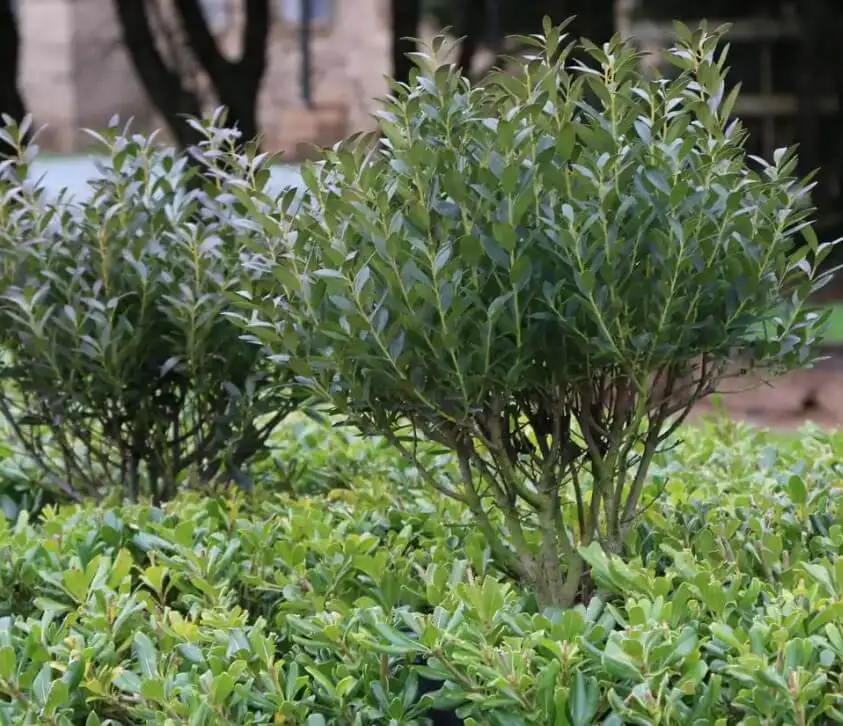
Inkberry, a native American holly species, thrives across regions from New England to Florida and west to Texas. Its adaptability allows it to flourish in diverse habitats such as maritime forests, swamp margins, and upland hardwood forests. As a low-growing shrub, Inkberry typically reaches four to six feet in height, with dark green and glossy leaves boasting a prickly texture.
In early summer, the plant produces small white flowers, followed by the ripening of black fruits in late summer and early fall. Inkberry is an exemplary choice for wildlife gardens, as its fruits are devoured by various bird species like thrushes, robins, waxwings, and catbirds. Its foliage provides shelter for small animals, while its dense growth habit can be leveraged to control erosion on slope sites.
Additionally, Inkberry makes a great candidate for foundation plantings, hedges, and massing in naturalistic landscape designs.
Japanese Holly (Ilex crenata)

A native to Japan, Japanese Holly is an evergreen shrub renowned for its dark green, glossy leaves and tiny white flowers. Its dense growth habit makes it a sought-after choice for hedges and topiary design. For those looking to cultivate this plant, Japanese Holly can be successfully propagated through seed or cutting methods.
To thrive, it requires full sun to partial shade, as well as moist, well-drained soil with a pH range that accommodates clay soils, demonstrating its adaptability to diverse environments.
Longstalked Holly (Ilex pedunculosa)
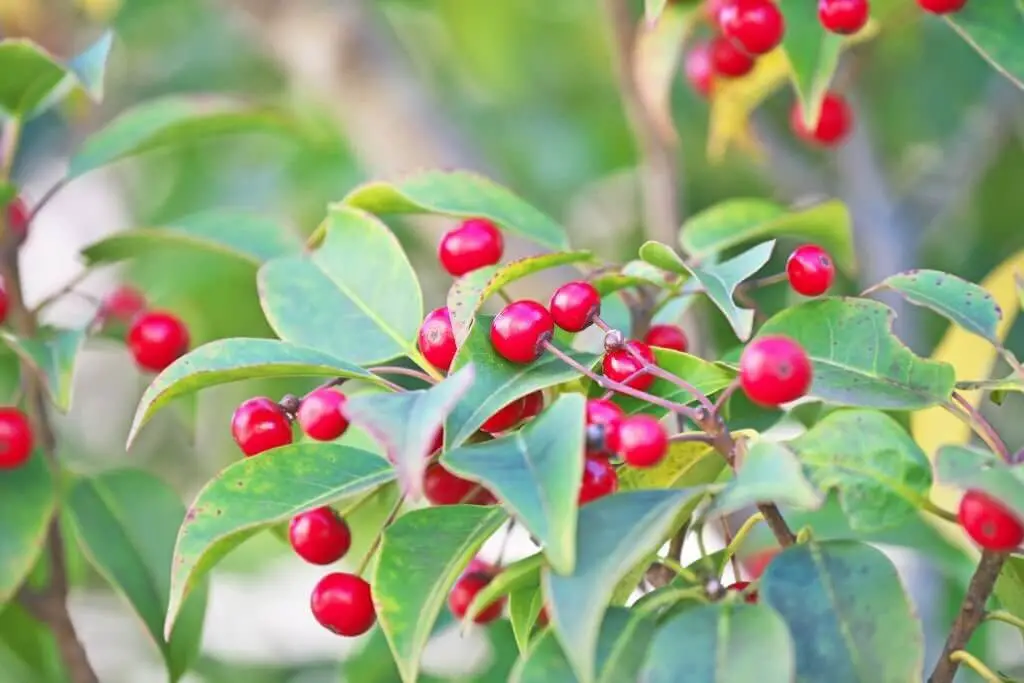
Longstalked Holly (Ilex pedunculosa) is a deciduous species that thrives in the eastern United States. Its dark green, leathery leaves feature sharp spines along their margins, providing a unique visual characteristic. The plant produces white flowers in clusters of three to five, while its red berries ripen in late summer or early fall. This remarkable holly plays a vital role as a larval host for the Henry’s Elfin butterfly (Callophrys henrici), allowing the caterpillars to develop and emerge.
Additionally, several bird species, including the American Robin (Turdus migratorius), Cedar Waxwing (Bombycilla cedrorum), and Eastern Bluebird (Sialia sialis), rely on the berries as a vital food source.
Lusterleaf Holly (Ilex latifolia)

Lusterleaf Holly (Ilex latifolia) is a striking native evergreen shrub/small tree that thrives in the southeastern United States. Its natural habitats include woodlands, stream banks, and swampy areas. This versatile plant can grow up to 30 feet tall, with an equal spread, making it an excellent choice for hedges, screens, or standalone specimens. The leaves are a deep green hue, with a glossy sheen, and feature sharp spines along the margins.
In contrast, the tiny white flowers bloom in clusters, adding a touch of elegance to this already impressive plant. As the seasons change, the Lusterleaf Holly produces vibrant red berries that ripen in autumn and persist into winter. This hardy shrub is adaptable, tolerating both sun and shade, as well as a wide range of soil conditions, making it an ideal addition to any landscape.
Myrtle-Leaved Holly (Ilex myrtifolia)
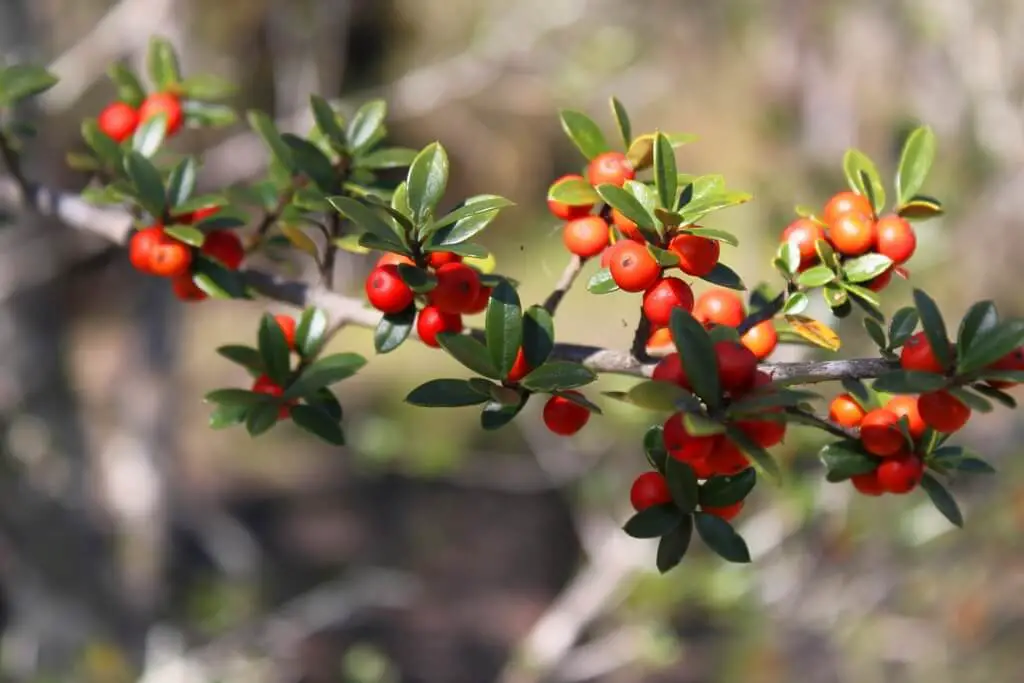
Native to the southeastern United States, stretching from North Carolina down to Florida, the Myrtle-Leaved Holly (Ilex myrtifolia) is a resilient species that thrives in its natural habitat. This evergreen tree can grow up to 15-20 feet tall, with leaves that boast a unique shape reminiscent of myrtle leaves and an unmistakable dark green, glossy sheen. As the seasons unfold, white flowers bloom in spring, followed by berries that ripen from fall to winter.
One of its most impressive attributes is its adaptability, as it can withstand salt spray and drought, making it an excellent choice for coastal landscapes. When planting Myrtle-Leaved Holly, opt for full sun to partial shade in well-drained soil to ensure optimal growth.
Needlepoint Holly (Ilex cornuta ‘Needlepoint’)

To produce berries, this female holly requires the presence of a male plant nearby. Its evergreen foliage features dark green, prickly leaves and vibrant red fruit. The long, sharp needles have earned it the nickname ‘needlepoint.’ This versatile holly thrives in well-drained soil and can tolerate both full sun and partial shade conditions.
With its low-maintenance nature and relative immunity to disease and pests, Needlepoint Holly is an excellent option for those seeking a berry-producing plant.
Nellie Stevens Holly (Ilex X ‘Nellie R. Stevens’)

Looking for a reliable and visually striking addition to your landscape? The Nellie Stevens holly is an exemplary choice, offering rapid growth and exceptional versatility. This evergreen hedge or screen can grow up to three feet per year, reaching heights of 20 feet within a decade. Its lustrous green leaves and vibrant red berries create a stunning display that’s sure to elevate any outdoor space. As a hardy plant, it thrives in a range of soils and prefers full sun to partial shade.
Moreover, once established, the Nellie Stevens holly is surprisingly drought-tolerant. Plus, its versatility allows for pruning to shape as desired, making it an excellent option for foundation planting or as a specimen plant.
Oak Leaf™ Holly Tree (Ilex x ‘Conaf’ P.P.# 9487)

The Oak Leaf Holly Tree is a stunning evergreen that boasts exceptional foliage, a dense growth habit, and vibrant red berries. Reaching heights of 12-15 feet tall with a spread of 15-20 feet wide, this tree is sure to make a statement in any landscape. Its leaves are a deep, rich green with spiny margins, measuring up to nearly five inches long.
While the fragrant white flowers that bloom in late spring may be hidden from view, they’re a sweet reward for those who take the time to appreciate them. As the seasons change and fall arrives, the tree is adorned with an abundance of shiny red berries, which can persist into winter. It’s worth noting that while these berries are toxic if ingested in large quantities, they add a pop of color and visual interest to the landscape.
The genus name ‘Ilex’ is derived from the Latin name for the holm or holly oak (Quercus ilex L.), while the specific epithet references the tree’s origins in Chile.
Possumhaw Holly (Ilex decidua)
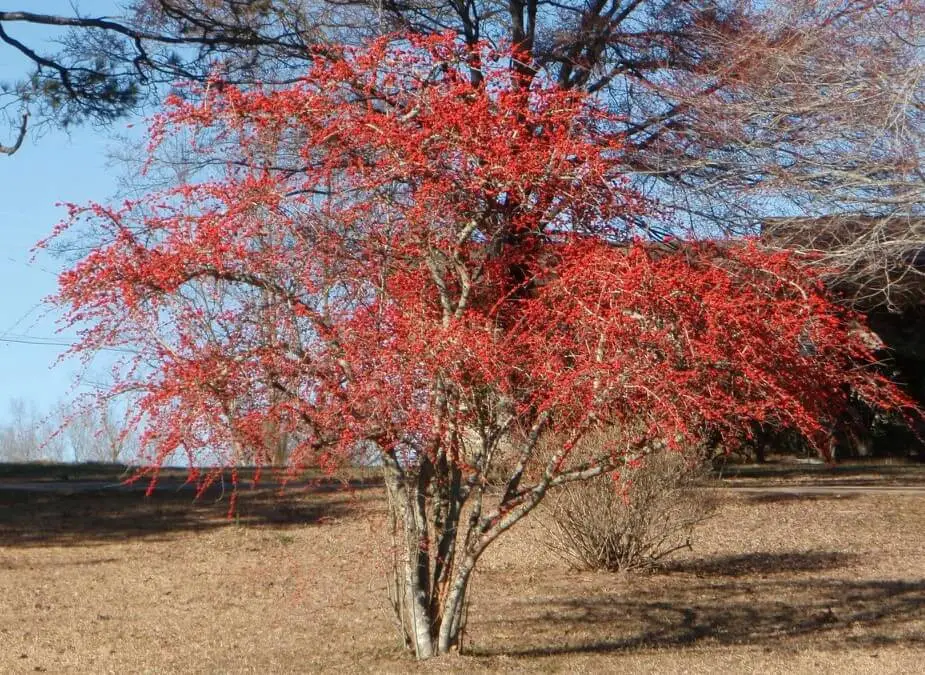
In its natural habitat, the Possumhaw Holly can be found thriving in woodlands, bottomland hardwood forests, and streambanks throughout the southeastern United States. This deciduous holly variety exhibits a unique characteristic – it can grow either as a small tree or large shrub, typically reaching heights of 15-20 feet. The leaves of the Possumhaw Holly are elliptical to oval in shape, boasting a dark green hue with a glossy finish.
As autumn arrives, these leaves transform into a vibrant display of yellow, orange, and red hues. Meanwhile, tiny greenish-white flowers bloom on the holly’s branches. The crowning glory of the Possumhaw Holly is its fruit – small, juicy red berries that provide sustenance for birds and other wildlife during the winter months. This plant plays a vital role in supporting local ecosystems, serving as both a vital food source and nesting site for various bird species.
Robin™ Red Holly Tree (Ilex X ‘Conin’)
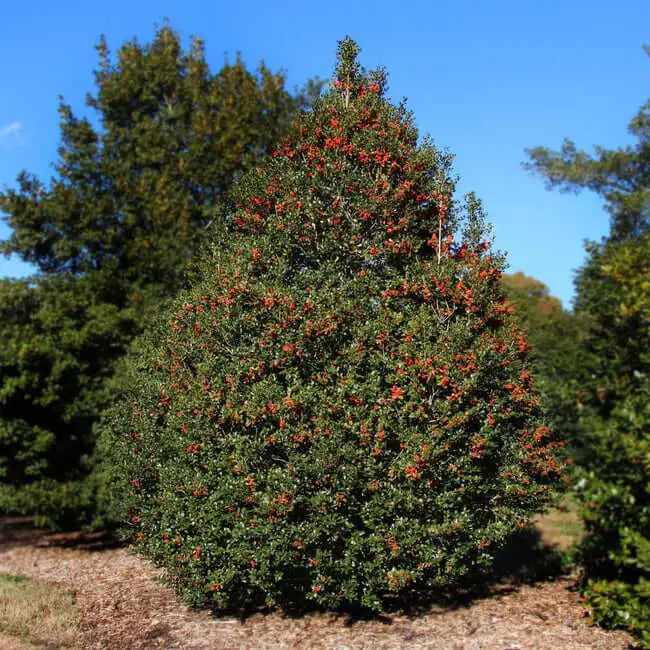
The Robin™ Red Holly Tree (Ilex X ‘Conin’) is a compact, dwarf variety that boasts striking deep red foliage. Reaching just 18 inches tall and 12 inches wide at maturity, it’s an ideal choice for creating a low hedge or foundation planting. This hardy holly is also surprisingly cold-tolerant, making it an excellent option for northern gardens where winter temperatures can drop quite low.
Its small stature and vibrant color make it perfect for smaller spaces, adding a pop of winter interest to the landscape.
Round Leaf Holly (Ilex rotunda)
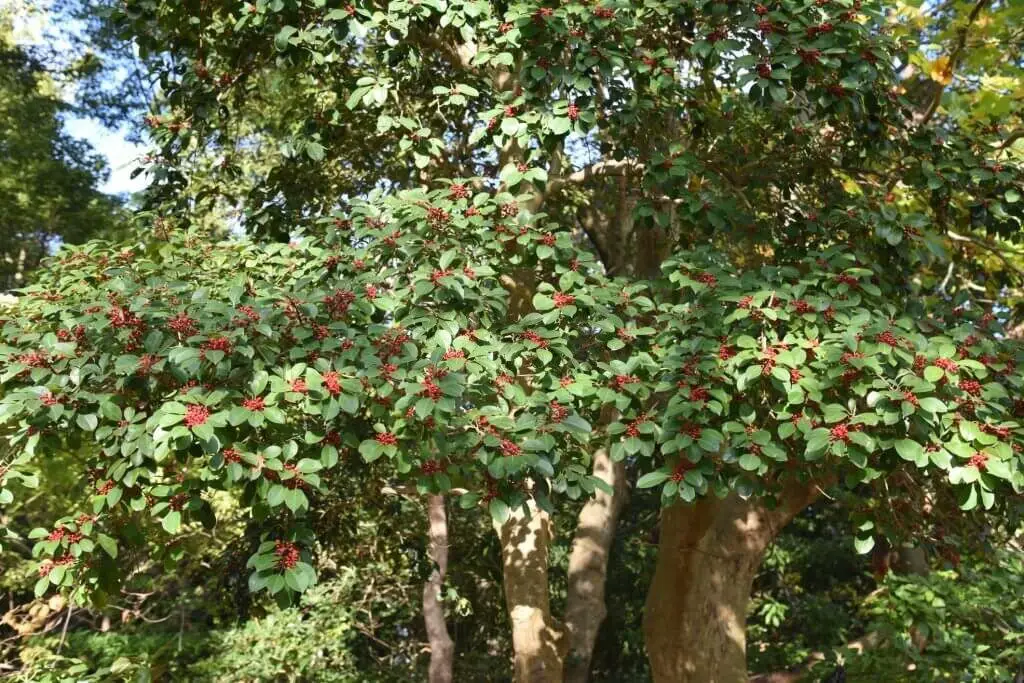
Round Leaf Holly (Ilex rotunda) is a fascinating species of holly that originates from China, boasting unique round leaves and vibrant red berries. Its ornamental value has made it a popular choice for gardeners, who appreciate its ability to add visual interest to their outdoor spaces. This versatile plant boasts an impressive array of benefits. Not only can it help alleviate stress and anxiety, but it also has the power to improve sleep quality.
Furthermore, Round Leaf Holly is known to enhance the body’s natural defenses, giving a boost to the immune system.
Sky Pencil Holly Tree (Ilex crenata ‘Sky Pencil’)
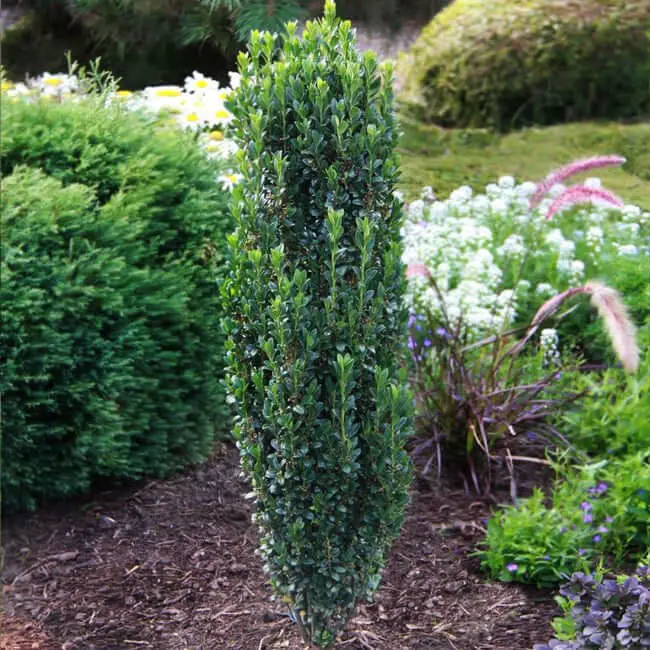
For those seeking a statement piece for their outdoor space, the Sky Pencil Holly Tree stands out with its striking, slender silhouette. Reaching heights of up to 15 feet and maintaining a width of just four feet at maturity, this slow-growing tree is an ideal choice for creating natural boundaries or screens.
Its versatility extends beyond aesthetics, as it also boasts deer resistance and minimal susceptibility to pests or diseases, making it a popular option for both residential and commercial landscapes.
Small-Leaved Holly (Ilex canariensis)
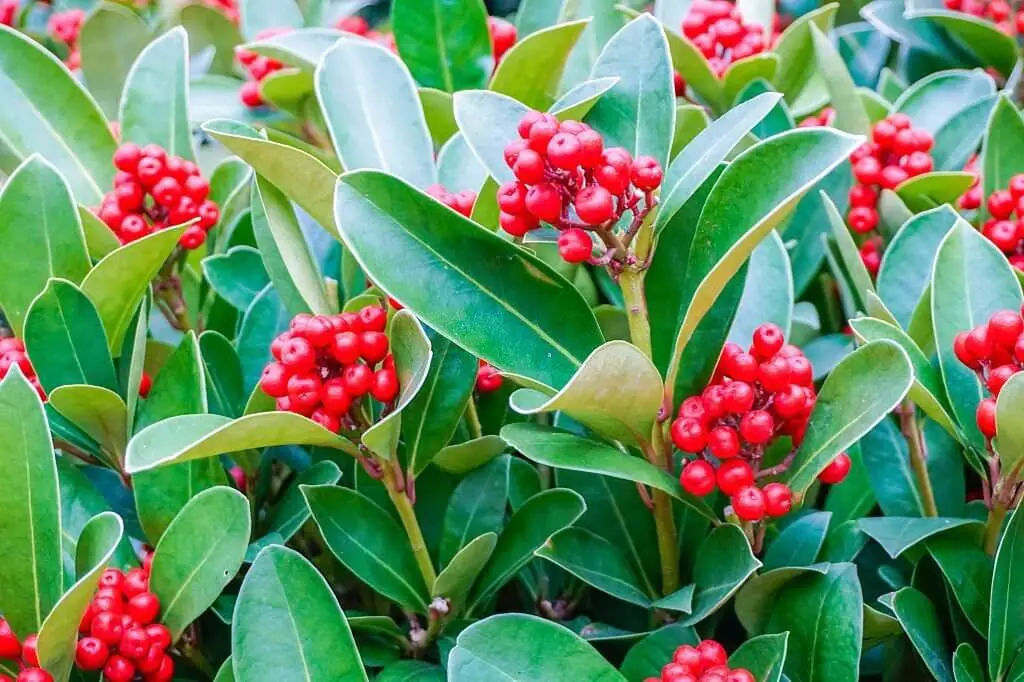
Small-Leaved Holly, a native species of holly from the Canary Islands, is characterized by its small, glossy, and dark green leaves. These leaves are a distinguishing feature of the shrub or small tree, which can grow up to 15 meters tall. The foliage is smooth and has a sharp spine at the tip, making it a unique and attractive feature. Additionally, Small-Leaved Holly produces white flowers that bloom in clusters of two to five, followed by red berries.
This evergreen plant’s striking combination of dark green leaves, white blooms, and vibrant fruit makes it a popular choice for gardens and landscaping.
Soft Touch Holly Shrub (Ilex crenata ‘Soft Touch’)

This compact shrub typically reaches heights of around two feet, yet spreads much wider as it matures. Its dark green leaves boast a fine texture, while small white flowers bloom in late spring, followed by black berries in the fall. A notable selection is ‘Soft Touch’, which offers improved growth habits and enhanced resistance to leaf spot. For optimal results, provide full sun; however, this shrub can tolerate some light shade as well.
It thrives in moist, well-drained soils but will adapt to a range of conditions, including clay. Although it may take time for the shrub to establish itself, once settled, it exhibits remarkable heat and drought tolerance.
Southern Gentleman Winterberry (Ilex verticillata ‘Southern Gentleman’)

Southern Gentleman Winterberry, a deciduous holly, stands out with its unique male flowers featuring long, striking stamens. In contrast, the female flowers are relatively inconspicuous. This dioecious species requires both male and female plants for successful pollination and fruit production. The fruits themselves become a vital food source for various birds such as robins, cedar waxwings, and bluebirds, while also attracting squirrels and other small mammals.
Native to the southeastern United States, this holly thrives in wetland environments. As a relatively slow-growing plant, it can reach impressive heights of 15 feet or more. It tolerates both full sun and partial shade, preferring moist, well-drained soils. This versatile holly is an excellent choice for native plant gardens or naturalized landscapes, and can also be used as a specimen plant or in mass plantings.
Winterberry Holly (Ilex verticillata)
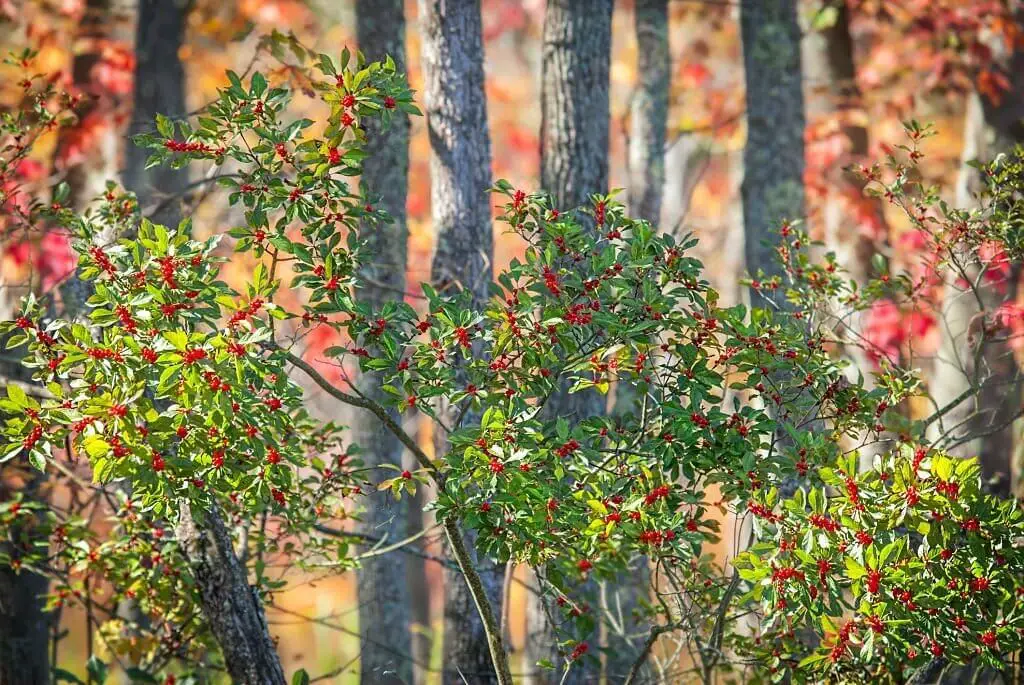
Winterberry Holly (Ilex verticillata) is a deciduous holly native to eastern North America, spanning from Newfoundland to Minnesota and south to Florida and Louisiana. It thrives in wet woods, swamps, and bogs. The species has gained popularity as an ornamental plant due to its striking winter berries. The specific epithet ‘verticillata’ refers to the unique leaf arrangement, where leaves grow in whorls of three to six around the stems.
These simple, alternate leaves are elliptical or ovate in shape, measuring 0.75-1 inch (19-29 mm) long and 0.67-13/16 inches (17-21 mm) wide. The upper leaf surface is a deep green with a lustrous finish, while the lower surface has a duller tone; both are hairless. The petiole length varies between male and female plants, measuring around 0.12 inches (30 mm). Leaf venation is pinnate, featuring five to seven primary vein pairs.
Winterberry Holly produces white or greenish-white flowers in axillary clusters of two to six. These tiny blooms, measuring about 0.12 inches (30 mm) in diameter, feature four petals and four sepals that remain attached after blooming. The plant exhibits dioecy, with male and female flowers growing on separate plants. Male flowers have longer stamens, while female flowers boast shorter stamens and a pistil with two styles. Blooming typically occurs from late April to early May.
Fruit production takes place in September-October, resulting in drupes approximately 0.16-0.20 inches (41-51 mm) in diameter. Each drupe contains two or three seeds. The fibrous root system spreads via stolons, often forming large colonies that cover vast areas of wetland habitat.
Yaupon Holly (Ilex vomitoria)
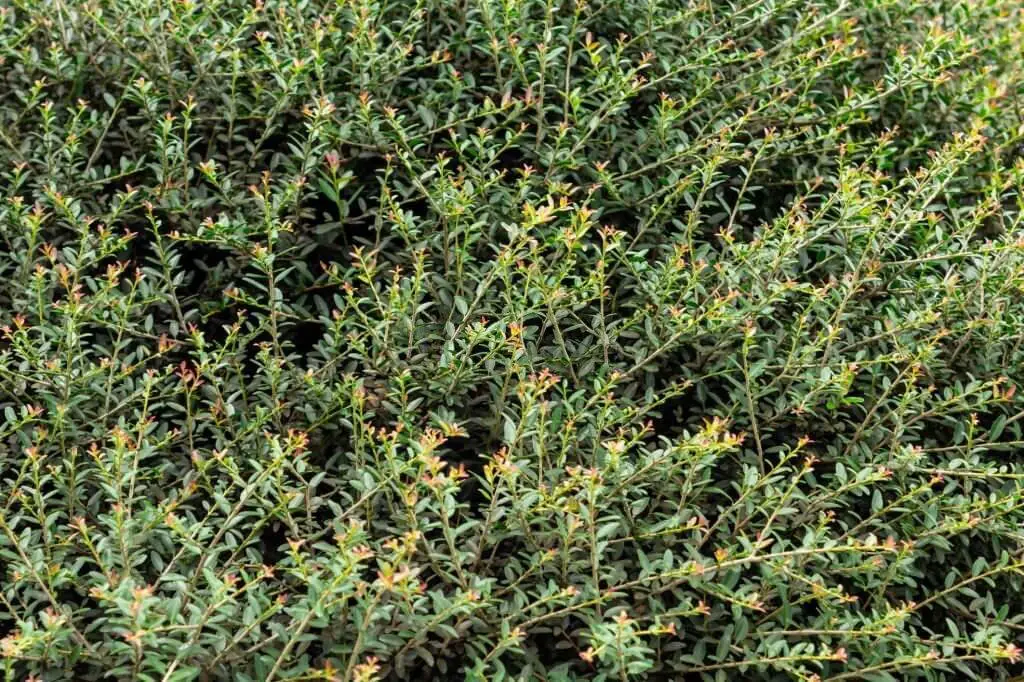
In the southeastern United States, Yaupon Holly (Ilex vomitoria) thrives as an evergreen shrub or small tree. Its adaptability allows it to flourish in a range of habitats, from swamplands to dry uplands, and can reach heights of up to 15 feet – although most specimens are much smaller. The plant’s leaves are distinguished by their dark green color and glossy texture, accompanied by sharp spines along the margins.
In spring, small white flowers emerge, followed by the appearance of bright red berries. Yaupon Holly plays a vital role as a host plant for various butterfly and moth species. Interestingly, its name ‘Yaupon’ originates from the Native American Yamassee Tribe, meaning ‘to vomit’, stemming from its use in a ceremonial purge believed to cleanse both body and soul.
A notable characteristic of Yaupon Holly is its active ingredient – caffeine – making it the only known plant in North America containing this stimulant.
Yerba Mate (Ilex paraguariensis)
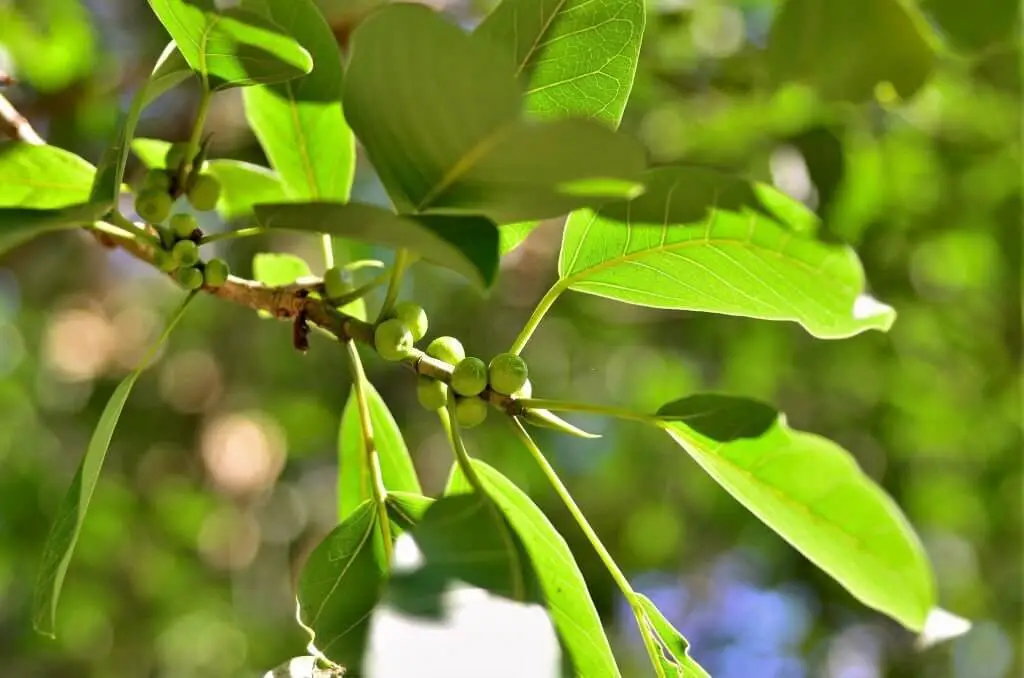
Yerba Mate, a species of holly native to subtropical South America, has been an integral part of the region’s culture for centuries. Its leaves and twigs are used to brew a traditional tea, also called mate, which is consumed in various forms throughout central and southern regions of Argentina, Uruguay, Paraguay, Bolivia, southern Brazil, and northern Chile.
The plant has a rich history of use by indigenous people, with the Guaraní tribe having a particularly significant legend surrounding its origin.
According to the tale, a beautiful woman named Alehuén was betrothed to a cruel man, prompting her to flee into the forest in fear for her life. Years later, her people discovered her living in a cave, where she claimed to have found eternal life with a plant she called yerba mate.
Today, yerba mate is enjoyed throughout South America, particularly in Argentina, Uruguay, Paraguay, and Brazil. The traditional method of consumption involves brewing the leaves and twigs with hot water and drinking from a gourd (cuia) passed around with a metal straw (bombilla).
How to care for Holly trees
To keep your holly tree looking its best, it’s essential to provide proper care. This includes a combination of watering, fertilizing, and pruning. Here are some key tips to help you achieve optimal results: When it comes to watering, aim for deep soaking once a week during the growing season. Use a slow and deliberate approach to ensure the water penetrates the root zone effectively. Fertilization is also crucial, as holly trees require a balanced diet to thrive.
Apply a fertilizer in early spring, following the manufacturer’s guidelines for dosage and frequency. Pruning plays a vital role in maintaining your holly tree’s health and appearance. Perform this task in late winter or early spring, just before new growth begins.
FAQs
Is a holly a tree or a bush?
Woody plants like trees and bushes are a familiar sight in many landscapes. However, the classification of these plants can be nuanced, particularly when it comes to holly. This plant, which belongs to the Ilex genus, encompasses around 600 species of flowering plants. Most hollies share two distinct characteristics: they retain their leaves year-round as evergreens, and they exhibit dioecy, where male and female flowers grow on separate individuals.
Holly’s adaptability is reflected in its global distribution, ranging from the icy tundras of Antarctica to the scorching deserts of Africa. In North America, Ilex opaca, or American holly, is one of the most prevalent species. This evergreen tree can reach heights of up to 40 feet, showcasing its remarkable ability to thrive in diverse environments.
Which holly trees grow the fastest?
When it comes to determining the growth rate of a holly tree, several factors come into play. The species of holly tree itself, the growing conditions, and the age of the tree all have an impact on its ability to grow. For instance, the American holly (Ilex opaca) is known for being one of the fastest-growing holly trees, with a growth rate of around 24 inches per year. However, this can vary depending on the specific growing conditions.
In ideal conditions, this tree has been known to grow up to 36 inches per year. The European holly (Ilex aquifolium) is another fast-growing holly tree, typically adding 18-24 inches per year. On the other hand, the Japanese holly (Ilex crenata) is a slower-growing holly tree, with a growth rate of around 12-18 inches per year. However, it’s worth noting that this species can still grow up to 24 inches per year in ideal conditions.
In addition to the type of holly tree and growing conditions, age also plays a significant role in determining its growth rate. Younger trees tend to grow faster than older trees because they are devoting more energy to growth and haven’t yet reached their full potential size.
What is the smallest holly tree?
While the exact dimensions may be unknown, the smallest holly tree on record is believed to be the Dwarf Yaupon Holly. This diminutive tree stands at an impressive yet unassuming six feet tall and four feet wide, earning it a place among the world’s smallest trees. Indigenous to the southeastern United States, the Dwarf Yaupon Holly can be found thriving in the regions of Texas, Louisiana, Mississippi, Alabama, and Florida.
What are holly trees good for?
Holly trees have been prized for their versatility and beauty throughout history. With their robust branches and sturdy trunks, they offer numerous practical applications beyond their aesthetic appeal. Not only do holly trees provide respite from the sun’s intense rays during hot summer months, but they also yield durable wood suitable for crafting furniture pieces.
Additionally, these evergreen wonders can be repurposed as decorations to add a touch of festivity to your home, or used to create meaningful gifts that symbolize goodwill and camaraderie. Whether planted near windows, incorporated into garden designs, or showcased as standalone features, holly trees continue to captivate with their multifaceted charm.
Are hollies evergreens?
Hollies, a type of evergreen plant, retain their leaves year-round. Native to Europe, Asia, and North America, these plants thrive in woods, hedges, and even gardens. With over 600 species to choose from, it’s no wonder why hollies are a popular choice for landscaping and decorative purposes. Despite their global distribution, many species of holly can be found growing alongside oak, locust, Christmas, and redbud trees, making them a common sight in natural habitats.
Conclusion
When it comes to selecting the ideal holly trees for your yard, having a diverse range of options can be both a blessing and a curse. With so many types to choose from, it’s easy to get overwhelmed by the sheer variety. But don’t worry, we’ve got you covered! Our list of the 11 best types of holly trees will provide you with all the inspiration you need to find the perfect tree for your home.
And once you do, you’ll be well on your way to creating a lush and vibrant outdoor space that’s sure to bring joy to you and your family.
Related Posts
Discover the vast array of plant varieties available online, from apple trees to evergreens. Learn how to become an arborist and pursue a career in tree care, or explore the significant impact trees have on your property. Not only can they boost your home’s appeal, but removing them strategically can also enhance its aesthetic. For those seeking a unique alternative to Bradford Pear, consider the Cleveland Pear Tree.
Alternatively, cultivate the elegance of Lady Palm (Rhapis excelsa) with our growing tips and care advice.



